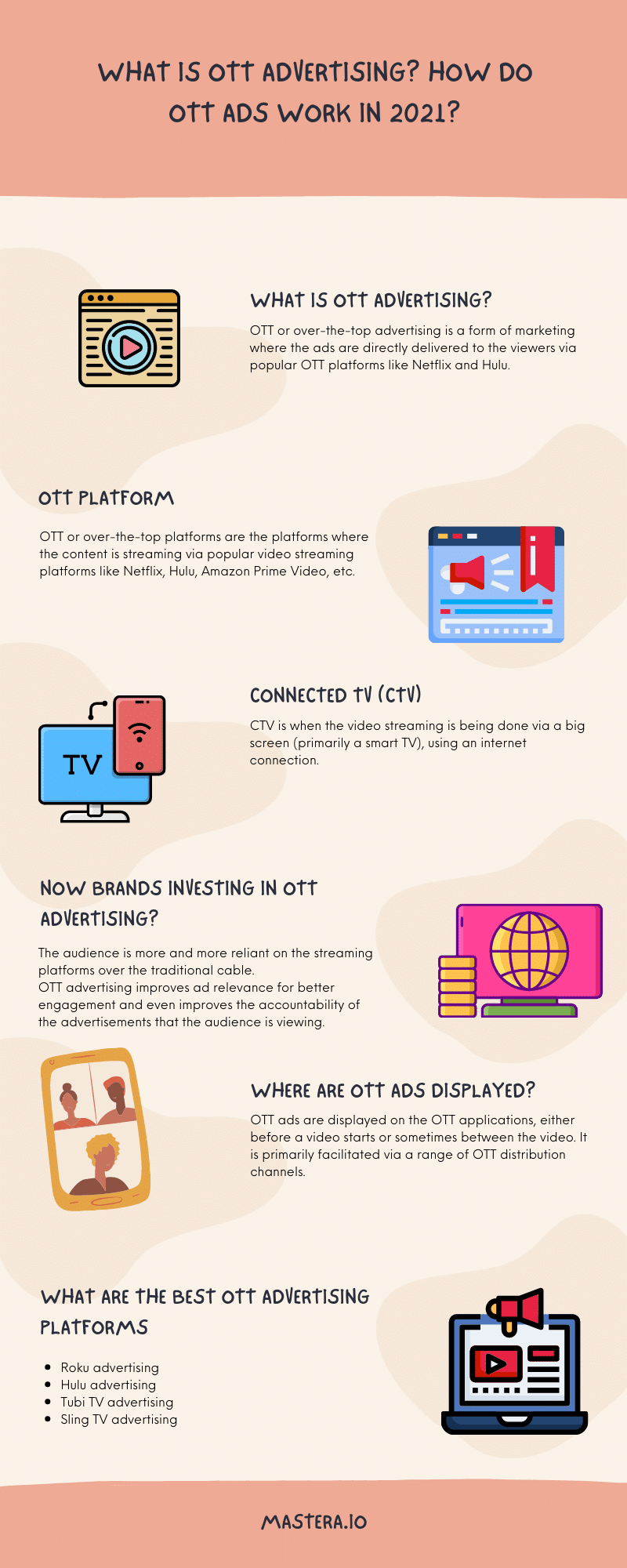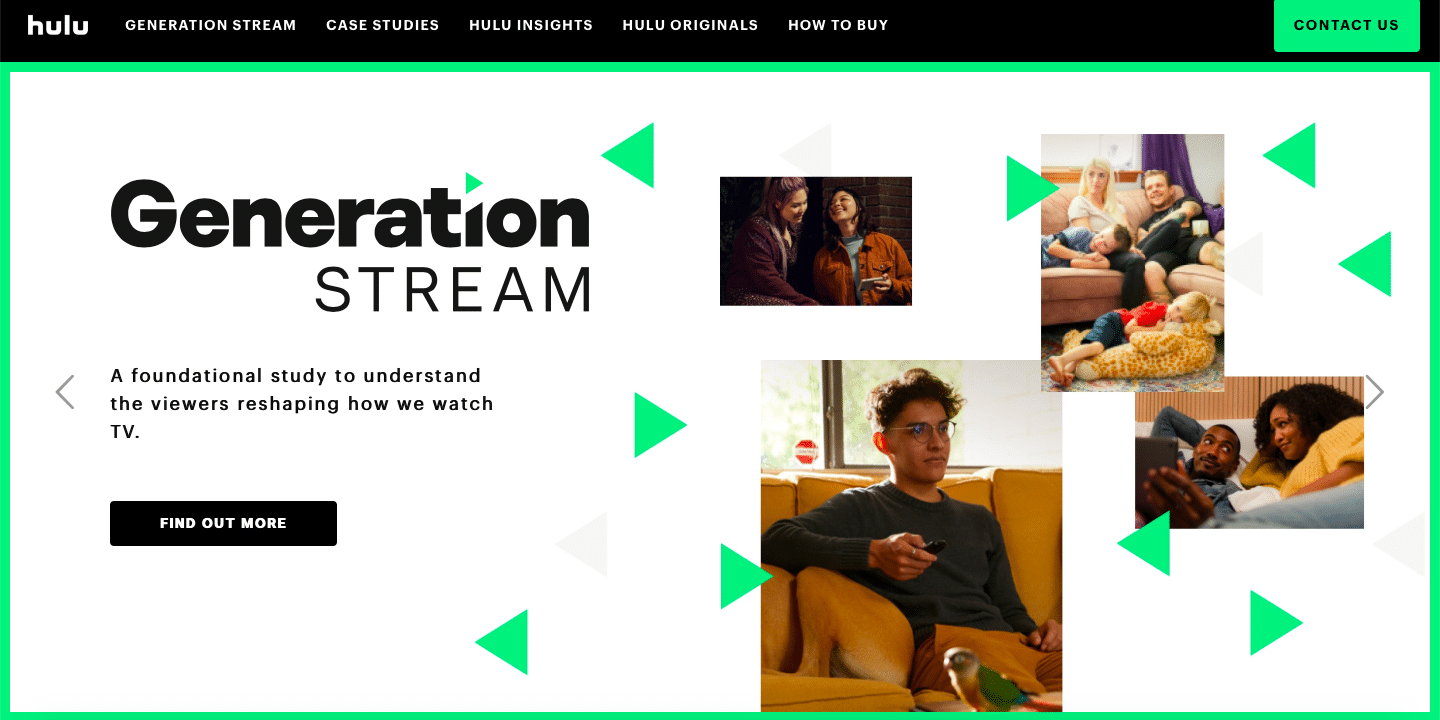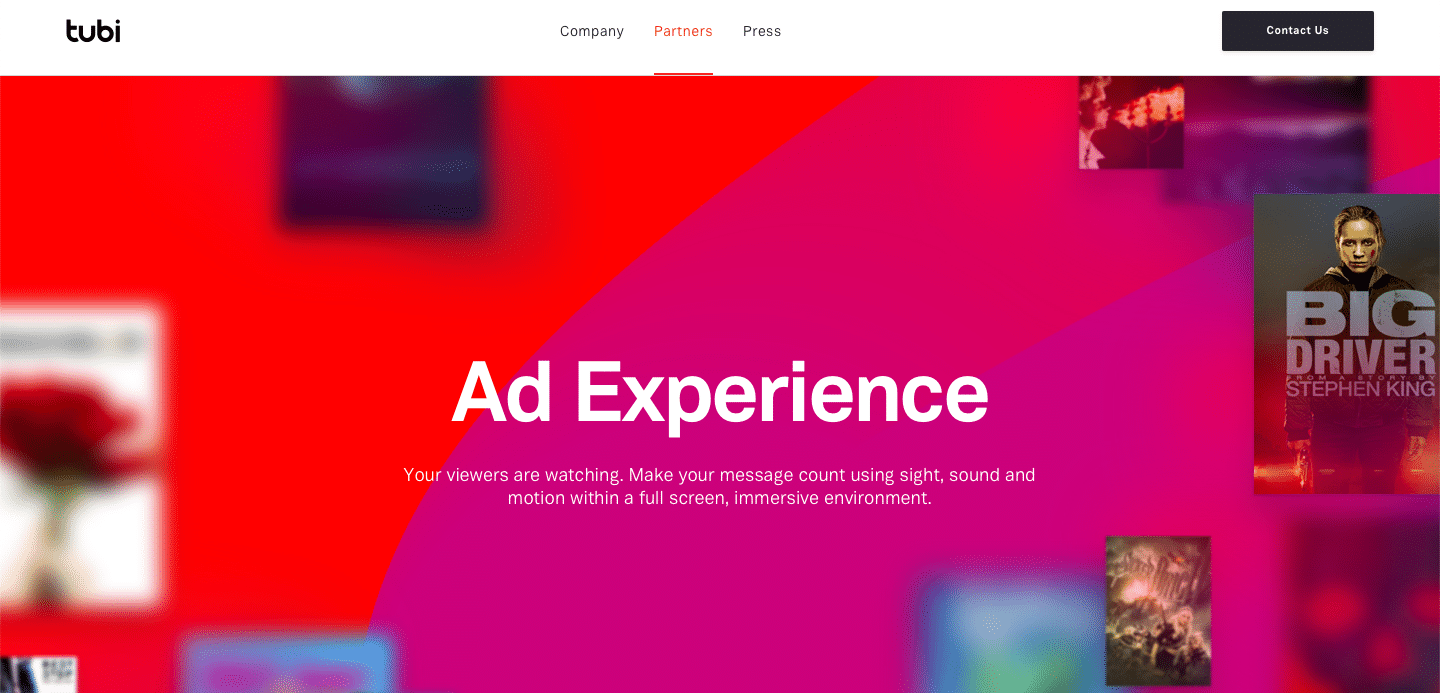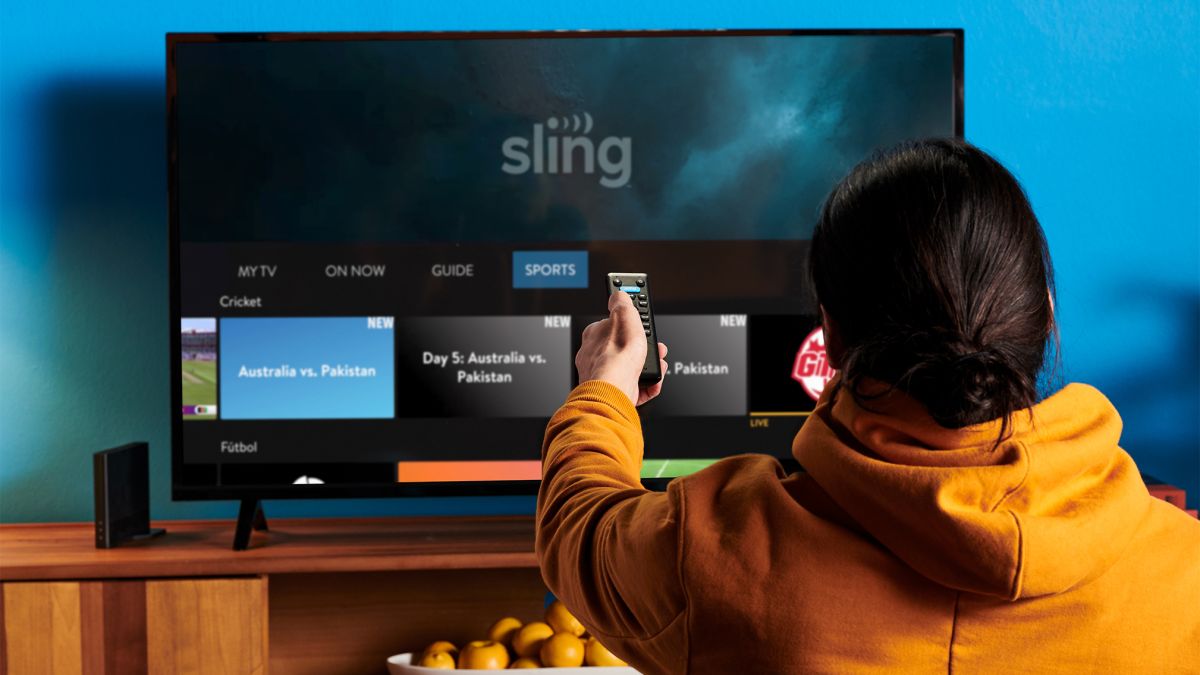What if we preface their blog by saying that the global OTT market size is expected to reach over $1000 billion by 2027? It sounds like a ridiculous number, doesn’t it?
The pandemic, accessibility, and affordability of the video streaming services are the primary reasons behind the sharp spike.

While traditional TV ads were a go-to marketing source for major brands a few years back, things have shifted now, and OTT advertising has taken the cherry on the cocktail. Here, we will be discussing that and a lot more that you need about OTT advertising.
What is OTT advertising?
OTT or over-the-top advertising is a form of marketing where the ads are directly delivered to the viewers via popular OTT platforms like Netflix and Hulu. The advertisements aren’t anything drastically different than what you’d get to view on traditional television.
The only difference is the source it is delivered from.
Statistics suggest that the OTT ad revenue will multiply and increase to 60% from the standard 45%, which is prevalent now. This itself goes to show how popular OTT advertising is becoming over time.
The superior aspect to OTT advertising is that it’s a lot more flexible and isn’t bound by the limitations of the broadcast schedules or the geographic limitations. This means that a person watching a show on Netflix at 10’o clock PST can watch the displayed ad as the viewer watching the same show at 10’o clock IST.
Difference Between OTT and Connected TV (CTV)
While people had a hard time adjusting to the concept of OTT in the beginning, introducing CTV became a further uproar. So, if you are sitting here confused as to what CTV is, let us clear out that doubt for you.
OTT or over-the-top platforms are the platforms where the content is streaming via popular video streaming platforms like Netflix, Hulu, Amazon Prime Video, etc.
On the other hand, CTV is when the video streaming is being done via a big screen (primarily a smart TV), using an internet connection. Not just smart TV, this category can also include other internet connectivity devices like Roku and Amazon Fire Stick.
Why are Brands Investing in OTT advertising?
If we had to answer your question in three words, it would be “Because it sells.”
To think that the OTT platforms are just diminishing the popularity of the cable TV operation would be a lie. These video streaming platforms are also affecting the overall prospect of traditional TV advertisements. It is quickly reshaping every brand’s paid marketing strategy, and that involves advertisements too.
1. It is a full-funnel performance driver
Over the top platforms are quantifying and evolving with more audience engagement over the years. As it scales and grows, it further promotes data-driven targeting, which is a prime factor in getting the right ads to the right people.
Since OTT platforms involve retargeting ads, brands are leveraging this feature to their benefit to drive their ads to their target audience to ensure successful conversions eventually. This mimics the functions of a full-funnel performance that contributes to enhances brand awareness and engagement for a brand.
Compared to traditional TV advertising, OTT advertising improves ad relevance for better engagement and even improves the accountability of the advertisements that the audience is viewing.
2. It has prospects of continued growth
Another reason brands are successfully investing more in OTT advertising is improved ad investments and better growth of the brands in the process. The future of TV is now becoming more digital-driven, with the audience being more and more reliant on the streaming platforms over the traditional cable.
Even the OTT stats show that the viewership has increased drastically, especially among the younger audience. The OTT advertising examples will show you that most of the ads are catered towards the younger audience since the viewership includes more of a younger audience than senior people.
Even a report found that the primary viewership of OTT platforms in the United States skirted between the ages of 18 to 34 years old, accounting for 70% of the viewers. Also, the numbers further suggest that brands have invested over $900 million on OTT advertising in 2020 itself.
The OTT advertising options are growing and becoming more sophisticated, not to mention that they offer optimal levels of personalization for the brands to churn maximum sales into their funnel.
Where are OTT Ads Displayed?
OTT ads are displayed on the OTT applications, either before a video starts or sometimes between the video. It is primarily facilitated via a range of OTT distribution channels.
Say, for example, you are watching an SVOD channel like Netflix or Amazon Prime Video, and you navigate to a series that you’d like to watch. Once you click on the series you want to watch, the chances are that a skippable or non-skippable ad will pop up at the beginning of the video. It can also very rarely appear during the middle pausing the video that you are watching.
So, in short, OTT ads can be displayed on channels including:
- SVOD or subscription video-on-demand platforms
- AVOD or advertising-based video-on-demand platforms
- vMVPDs or multichannel video programming distributors
- CTV or connected TV
What are the best OTT advertising platforms?
There are many OTT advertising platforms that brands leverage to either advertise their products, services, or presence. Some of the popular ad distribution channels include:
- TV publishers
- OTT native services
- OTT devices
For your convenience, we are going to give a quick rundown of the best OTT advertising platforms.
1. Roku advertising
With over 51.2 million monthly viewers, Roku is hands down one of the most popular OTT platforms in the United States. If you are a brand interested in leveraging Roku for native advertising, they have 15-30 seconds ad spots in between the videos.
2. Hulu advertising
You’d think that on-demand or subscription-based video demand platforms won’t have OTT advertising. That isn’t the case, and Hulu advertising is here to clarify your doubts. They offer bidding, targeting, and other types of personalized ads that brands can make the maximum use out of.
3. Tubi TV advertising
Although a little underrated with 33 million monthly viewers, Tubi TV doesn’t fall much behind Hulu. When it comes to advertisements, the platform supports 15-30 seconds non-skippable ads that the brands can leverage to amplify their outreach.
4. Sling TV advertising
Another popular platform that integrates OTT advertising is Sling TV. With over 2.2 million subscribers in the United States alone, Sling TV supports the unique range of programmatic advertising for better outreach.
How can You Buy OTT ads?
If you are wondering how to buy OTT ads, the process is a little complicated, especially for beginners. Before anything, you need to familiarize yourself with the two available types – Guaranteed Insertion Orders and the Programmatic Ads.
1. Guaranteed IO (insertion orders)
These include the set-priced ads and come with a set outreach and impressions, depending on the brand’s reach.
2. Data-drive Programmatic
These are harder to acquire and depend on real-time bidding that offers full flexibility in the advertiser’s hands and the involved agency to choose their target audience for better impressions.
Now that you know the types, let us focus on the factors you need to look out for:
3. Know the audience criteria
When you are buying OTT ads, your primary aim is to reach your target audience. When doing so, you need to look out for the sales offer, audience, KPIs, and the kind of marketing campaign your ad focuses on. As the OTT industry evolves and improves, it will eventually become a lot more refined with its results and impressions.
4. Decide where to buy
Keeping the targeting aside, you also need to focus on where you will buy the OTT ad inventory from. Will it be from the publishers or the platforms? Both of them come with their set of pros and cons that you need to research and decide on.
5. Focus on the design
Just buying the OTT ad inventory isn’t enough, especially if you don’t focus on designing the ad the right way. So, when you have secured your purchase, focus on curating the ad the right way with all the important elements like the storyline, call to action, design, and final execution.
6. Understand the performance abilities
Lastly, focus on the metrics after publishing the first ad. Is it showing results? Is it reaching the correct audience? These are some of the data you need to look out for after purchasing the OTT ad space.
3 Best Practices for OTT Advertising
Given how popular OTT advertising has become, the last thing you want is to screw up the results. It has the potential to drive your sales up only if you do things the right way.
Since OTT viewers are advanced audiences, it isn’t surprising that they are looking for nothing but the best for the ads. The last thing you want is to provide them with a bad video ad experience.
Following are some of the best practices you can integrate into your ad:
1. Focus on the formatting
When an OTT platform is showcasing a specific ad, you never know which device the audience is viewing the ad from. It can be from their smartphone or even their smart TV. In such cases, your inserted ad must be playable and compatible in multiple formats. Focus on the sizing and the closing call to action in the end.
2. Limit it to 30 seconds
You’d be surprised to know this, but the majority of the OTT advertising is non-skippable. This means that while the viewer is trying to watch their favorite episode in the series, a minute-long ad will make them angry. So, try to keep your ad length 30 seconds or less with catch titles and CTA to drive substantial sales.
3. Deliver personalized experience
Getting your ads to the targeted audience is your end goal with OTT advertising. So, when curating your ads, you need to ensure that the look and feel of your ads reflect what the audience will need or expect. A personalized experience is one of the key markers to a successful sale.
You may also like:
- What are SVOD, TVOD, AVOD? The Definitive Guide
- How Your VOD Business Can Compete with All the Free Online Content?
OTT Audience Targeting and Measurement
Like any other ad platform, even OTT advertising has multiple layers to it. However, compared to traditional cable TV advertising, OTT advertising has the benefit of correct audience targeting. This means that the ads, for the most part, reach the correct audience who are likely looking to invest in the brand’s product or service.
The majority of the audience targeting with OTT advertising is done via:
- Demographics
- Interests and online behavior
- Location (for native advertising)
Challenges of OTT advertising
While the blog primarily emphasizes the popularity and benefits of OTT advertising, we need to understand that OTT advertising comes with its fair share of challenges.
Some of the common challenges include:
- OTT advertising doesn’t have tools and support for third-party ad serving.
- OTT advertising is still predominantly new, lacking primary integration standards and guidelines in the industry.
- OTT platforms often lack cookies and flash support, limiting the extent of the audience targeting capabilities.
- Lack of standard measurement, especially of the audience metrics.
The Future of OTT advertising
Although still in its initial stages of cooking, the future of OTT advertising is very bright and accessible. There are a few projections and few possibilities that the brands and publishers are currently working on.
One of the most common future reiterations suggests that the brand will buy ad spaces directly from the OTT content providers. The future seems to be more inclined towards programmatic OTT advertising. This is more effective for the SVOD platforms with information about their subscribers and knows where their audience resides.
The free OTT platforms rely on third-party or external sources for the audience information, including that from ad-targeting from Google and their matching services.
Although the opportunities tied with OTT advertising are quite limited in today’s date, the future will introduce many improvements and developments. The publishers are expected to introduce more ways of enhancing the reach of the brands and further unlock the potential to its maximum heights.
FAQs Related To OTT Advertising
Is Netflix an OTT?
Yes, Netflix is an OTT platform. It is particularly a subscription-based video-on-demand platform when you need to pay a monthly subscription fee to access the content.
What is OTT strategy?
OTT strategy primarily focuses on the omnichannel approach where the publishers target the audience’s preferences across multiple content distribution channels.
What is an example of OTT?
Some of the finest and easiest examples of OTT are Netflix and Hulu, the platforms that you watch your favorite web series on.
What does OTT stand for?
OTT stands for over-the-top. It refers to the content that the audience view via the various streaming platforms using the internet.
Conclusion
OTT advertising is a concept that brands and consumers are getting used to right now. However, as OTT video consumption grows over the years, the chances are that the popularity of OTT ads will further evolve and rise. However, you need to know the right strategies, the correct implementation, and future projections.
With OTT platforms’ increasing share in the advertising market, the coming years will glorify this to its full potential. And, it won’t be long till it becomes one of the most lucrative forms of marketing for the brands.







